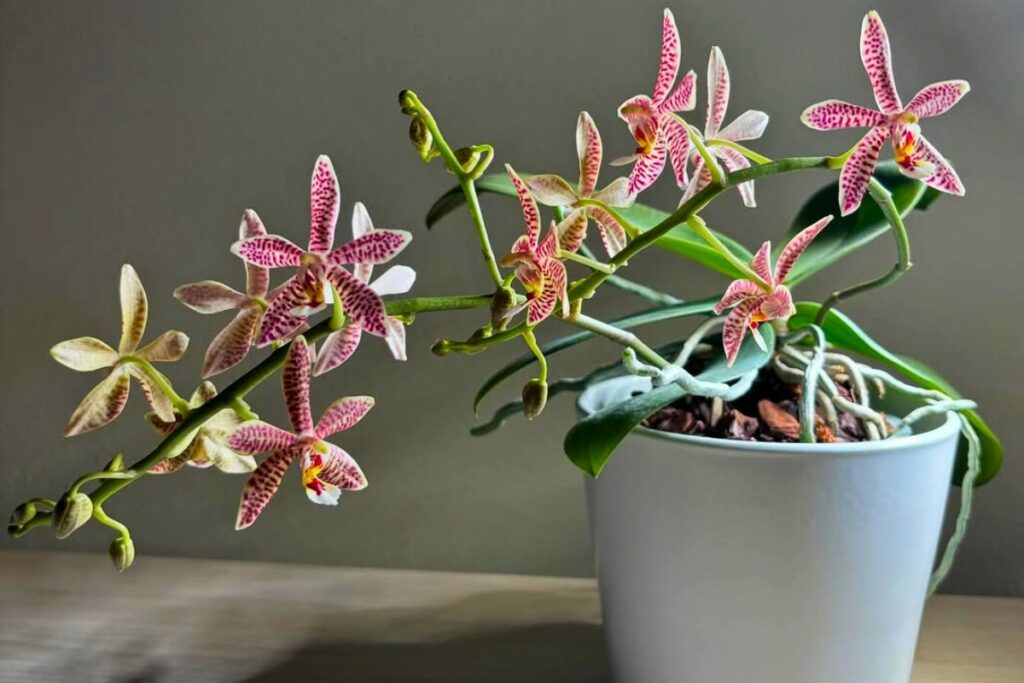If you’re growing Phalaenopsis orchids, you’ll quickly learn that the potting medium can make or break your success. These elegant plants don’t actually need soil – they’re epiphytes that naturally grow attached to trees in tropical forests. Instead, they thrive in a specialized mix that mimics their native environment. Understanding what goes into the perfect orchid medium will help you avoid the common pitfalls that lead to root rot and stunted growth.

Contents
Understanding Phalaenopsis Root Requirements
While Phalaenopsis orchids are often called “beginner-friendly,” their root system requires specific conditions to thrive. These thick, silvery-green roots need a delicate balance of moisture and airflow, unlike typical houseplants that grow in soil.
You’ll notice that healthy Phalaenopsis roots have a unique adaptive feature – a spongy outer layer called velamen that absorbs water and nutrients. When dry, these roots appear silvery-gray, but they’ll turn bright green when wet.
Your orchid’s roots need 40-60% humidity and shouldn’t stay constantly wet. They’re epiphytes in nature, meaning they grow attached to trees, getting nutrients from air and rainfall.

Popular Potting Media Components
To give your Phalaenopsis orchid’s roots the perfect environment, you’ll need to combine several specialized potting materials. The most essential components include fir bark, sphagnum moss, perlite, and charcoal, each serving a unique purpose in your mix.
High-quality fir bark should make up 60-70% of your medium, providing excellent drainage and aeration. You’ll want medium-grade chunks, typically 1/2 to 3/4 inch in size. Mix in 15-20% sphagnum moss for moisture retention, 10-15% perlite to prevent compaction, and 5-10% charcoal to keep the mixture fresh and help filter impurities.
Recommended Media Combinations
Three proven media combinations stand out for growing healthy Phalaenopsis orchids. The first blend combines 70% medium-grade fir bark with 20% perlite and 10% sphagnum moss, providing excellent drainage while retaining moisture. Your second option mixes equal parts fir bark and sphagnum moss, which works well in drier climates.
For the most versatile mix, you’ll want to combine 60% medium fir bark, 20% charcoal, 10% perlite, and 10% sphagnum moss. This blend offers superior aeration, moisture retention, and root protection. When mixing, break up any clumps and guarantee even distribution of components.
Signs Your Potting Medium Needs Replacement
Even the best potting mix won’t last forever in your orchid’s pot. Watch for several key indicators that signal it’s time for fresh media: decomposing bark that’s turned dark and crumbly, a potting mix that stays wet for more than 7 days, or roots that look brown and mushy instead of firm and silvery-green.
If you notice your orchid’s leaves becoming limp while the mix feels bone-dry just 2-3 days after watering, that’s another red flag. You’ll also want to check the pot’s weight – if it feels unusually light, the medium has likely broken down and lost its water-retention properties.
Repotting Techniques and Best Practices
Proper repotting timing and technique make all the difference in your orchid’s success. Wait until after flowering, when you’ll see new root growth emerging, typically in spring. You’ll get the best results during this active growth phase.
Start by removing the old medium and trimming any dead, mushy roots with sterilized scissors. Soak healthy roots in room-temperature water for 15 minutes. Select a pot that’s 1-2 inches wider than the root mass, ensuring it has plenty of drainage holes.
Position your orchid so the base sits 1 inch below the pot’s rim. Fill gaps with fresh medium, gently tapping to eliminate air pockets. Don’t water for 3-5 days.
